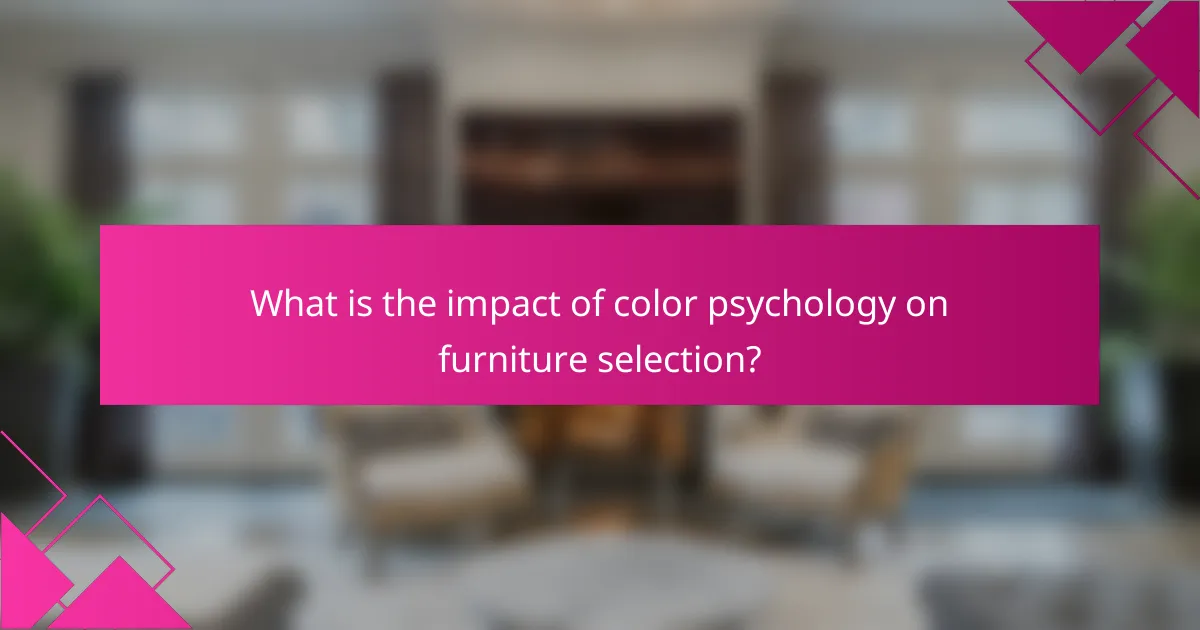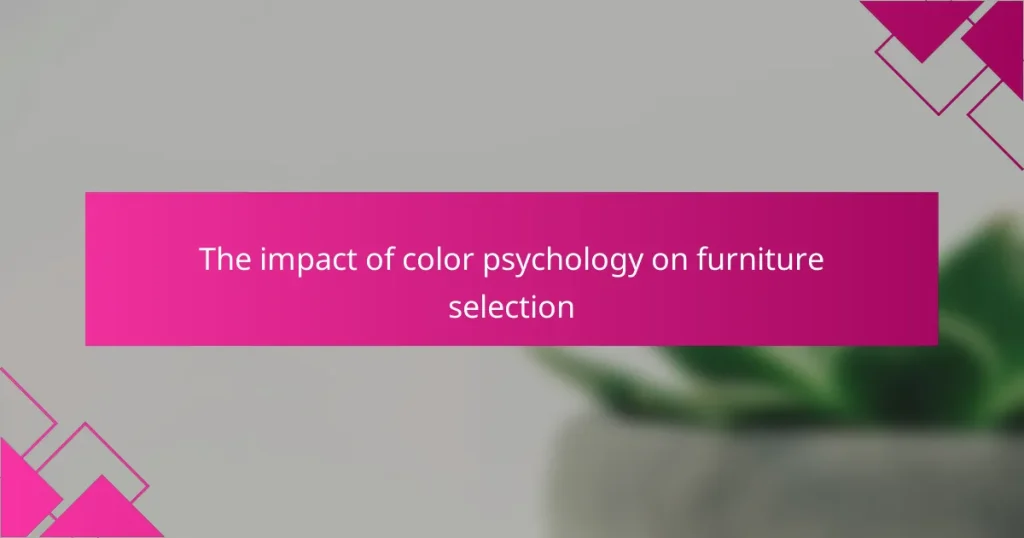Color psychology is the study of how colors influence emotions and perceptions, playing a crucial role in furniture selection. Different colors evoke specific feelings; for example, blue is linked to calmness, red to energy, green to balance, and yellow to happiness. This article examines how these associations guide consumers in choosing furniture that aligns with their desired ambiance. Research, including a study by Küller et al. (2009), supports the notion that color impacts mood and behavior, thereby influencing interior design decisions. Understanding color psychology can enhance the effectiveness of furniture selection in creating intended emotional responses within various spaces.

What is the impact of color psychology on furniture selection?
Color psychology significantly influences furniture selection. Different colors evoke specific emotions and perceptions. For instance, blue promotes calmness and tranquility, making it suitable for bedrooms. Red can stimulate energy and excitement, often chosen for social spaces. Green is associated with nature and balance, ideal for living rooms or offices. Yellow can evoke happiness and optimism, frequently used in kitchens and play areas. According to a study by Küller et al. (2009), color can affect mood and behavior, impacting choices in interior design. Therefore, understanding color psychology aids consumers in selecting furniture that aligns with their desired ambiance and emotional responses in their spaces.
How does color psychology influence consumer behavior in furniture choices?
Color psychology significantly influences consumer behavior in furniture choices. Different colors evoke specific emotions and perceptions. For instance, blue is often associated with calmness and trust. Consumers may gravitate towards blue furniture for a serene living space. Red, on the other hand, can stimulate energy and excitement. This may lead consumers to choose red furniture for vibrant areas like dining rooms.
Studies show that 90% of snap judgments about products are based on color alone. This indicates the importance of color in consumer decision-making. Additionally, color can affect perceived value. High-end brands often use black or gold to convey luxury.
A 2017 study by Satyendra Singh in the journal “Management Decision” found that color impacts consumer buying behavior significantly. The study revealed that color increases brand recognition by up to 80%. This underscores the role of color in furniture marketing and selection.
What are the psychological effects of different colors on mood and perception?
Different colors have distinct psychological effects on mood and perception. For example, blue is often associated with calmness and tranquility. Studies show that blue can lower heart rates and reduce feelings of anxiety. Conversely, red can evoke feelings of excitement or aggression. Research indicates that red increases heart rates and can stimulate energy levels. Yellow is linked to happiness and optimism, often enhancing creativity and mental clarity. Green promotes a sense of balance and harmony, which can reduce stress. Each color influences emotions and can shape how individuals perceive their environment. Understanding these effects can aid in effective furniture selection and interior design.
How do cultural differences affect color preferences in furniture selection?
Cultural differences significantly affect color preferences in furniture selection. Different cultures associate specific colors with distinct meanings and emotions. For example, in Western cultures, white symbolizes purity and cleanliness, making it a popular choice for furniture. In contrast, in many Eastern cultures, white can be associated with mourning.
Red is often favored in Chinese culture for its associations with good fortune and joy. This preference influences furniture choices, leading to the selection of red tones for auspicious settings. Similarly, blue is commonly associated with calmness in many cultures, impacting its use in furniture design to create serene environments.
Research indicates that cultural background shapes color perception and preference. A study published in the Journal of Cross-Cultural Psychology found that individuals from collectivist cultures tend to prefer warmer colors, while those from individualistic cultures lean towards cooler tones. This demonstrates how cultural context directly influences furniture color choices.
Why is color important in interior design and furniture selection?
Color is important in interior design and furniture selection because it influences mood and perception. Different colors evoke specific emotions. For example, blue can create a calming atmosphere, while red may stimulate energy. Color also affects spatial perception; lighter shades can make a room feel larger, while darker colors can create intimacy. Additionally, color can enhance or clash with existing decor. Research shows that color can impact decision-making; 85% of consumers make purchase decisions based on color. Therefore, selecting the right color is crucial for creating desired environments and experiences.
What role does color play in creating a cohesive design aesthetic?
Color plays a crucial role in creating a cohesive design aesthetic. It influences mood, perception, and visual harmony in a space. A well-chosen color palette unifies various design elements, such as furniture, decor, and walls. Consistent use of color can create a sense of flow and connection throughout a room. For example, complementary colors can enhance the visual appeal of furniture selections. Research indicates that color can evoke specific emotions, impacting how individuals interact with their environment. According to the Color Psychology in Marketing study by Satyendra Singh, 90% of snap judgments made about products are based on color alone. This underscores the importance of color in design cohesion.
How can color enhance or detract from the functionality of a space?
Color can significantly enhance or detract from the functionality of a space. Different colors evoke various psychological responses, influencing mood and behavior. For instance, blue promotes calmness and focus, making it ideal for workspaces. Yellow can stimulate creativity and energy, suitable for creative areas. Conversely, red may increase anxiety and distraction, potentially detracting from productivity. Research indicates that colors impact cognitive performance, with studies showing that specific hues can enhance concentration and efficiency. A well-chosen color scheme can improve the overall functionality of a space by aligning with its intended use and enhancing occupants’ experiences.
What factors should be considered when selecting furniture colors?
When selecting furniture colors, several factors should be considered. First, the psychology of color plays a significant role in influencing mood and perception. For example, warm colors like red and orange can energize a space, while cool colors such as blue and green promote calmness. Second, the existing color scheme of the room should be taken into account. The furniture color must complement or contrast effectively with the wall colors, flooring, and decor. Third, the purpose of the room is crucial. Different colors can evoke different feelings, which can impact functionality. For instance, vibrant colors may be suitable for creative spaces, while neutral tones work well in professional settings. Lastly, lighting conditions should also be considered. Natural and artificial light can alter how colors appear, affecting the overall ambiance.
How do lighting conditions impact the perception of furniture colors?
Lighting conditions significantly impact the perception of furniture colors. Different types of lighting, such as natural light, incandescent, and fluorescent, can alter how colors appear. Natural light tends to reveal the true color of materials. Incandescent lighting can warm up colors, making them appear richer. Fluorescent lighting often casts a cooler tone, which may dull colors. The intensity of light also plays a role; brighter environments can enhance vibrancy, while dim lighting may mute hues. Studies show that color perception can vary by up to 30% under different lighting conditions. This variability affects consumer choices in furniture selection, as colors may not appear as intended in various settings.
What are the best practices for combining colors in furniture selection?
The best practices for combining colors in furniture selection include using a color wheel for guidance. This tool helps identify complementary colors. Select a dominant color for larger furniture pieces. Use accent colors for smaller items like cushions or decor. Aim for a balanced color scheme with no more than three main colors. Consider the room’s lighting, as it affects color perception. Test colors in the actual space before making final decisions. Neutral colors can provide a versatile backdrop for bolder hues. These practices enhance aesthetic appeal and create harmonious spaces.
How can understanding color psychology improve furniture selection?
Understanding color psychology can significantly enhance furniture selection. Colors evoke specific emotions and reactions in individuals. For instance, blue is often associated with calmness and tranquility. This makes it an ideal choice for bedrooms or relaxation areas. Conversely, red can stimulate energy and excitement. It may be suitable for social spaces like living rooms or dining areas.
Research indicates that color can influence mood and behavior. A study by K. A. Valdez and A. Mehrabian found that color affects people’s feelings and perceptions. Choosing colors aligned with the intended atmosphere can create desired emotional responses.
Incorporating color psychology into furniture selection leads to more harmonious and functional spaces. This approach allows individuals to curate environments that reflect their preferences and enhance their well-being.
What strategies can be used to choose colors that align with personal style and needs?
To choose colors that align with personal style and needs, start by identifying your preferred color palette. Consider colors that evoke the emotions you wish to experience in your space. Use tools like color wheels to understand complementary and contrasting colors. Assess the lighting in your environment, as it affects how colors appear. Experiment with color swatches in your space to visualize their impact. Evaluate how colors interact with existing furniture and decor. Research color psychology to understand how different hues influence mood. Finally, trust your instincts; personal preference plays a crucial role in color selection.
How can color psychology help in creating specific atmospheres in different rooms?
Color psychology can significantly influence the atmosphere in different rooms. Different colors evoke specific emotions and reactions. For example, blue is known to create a calming effect, making it suitable for bedrooms. Yellow can stimulate creativity and energy, which is ideal for home offices. Green promotes relaxation and is often used in living spaces. Red can increase energy and passion, making it fitting for dining areas. Research indicates that color can affect mood and behavior, supporting these applications. A study by Külli et al. (2019) shows that colors impact cognitive performance and emotional responses. Thus, choosing colors wisely can enhance the intended atmosphere of any room.
What are some common misconceptions about color psychology in furniture selection?
One common misconception about color psychology in furniture selection is that colors have universally fixed meanings. In reality, color interpretations can vary significantly based on individual experiences and cultural contexts. For example, while blue is often associated with calmness in many Western cultures, it may evoke different feelings in other cultures. Another misconception is that brighter colors always create a more energetic atmosphere. However, overly bright colors can lead to visual fatigue and discomfort in certain settings. Additionally, people often believe that color alone dictates mood. In fact, factors like lighting and room layout also play crucial roles in how color is perceived. Research in environmental psychology shows that color can influence emotions, but it interacts with other design elements. Understanding these nuances can lead to more informed furniture selections that align with personal preferences and desired atmospheres.
How do myths about color influence consumer choices?
Myths about color significantly influence consumer choices by shaping perceptions and expectations. For example, many consumers believe that certain colors evoke specific emotions, such as blue promoting calmness or red increasing appetite. These beliefs can drive purchasing decisions, especially in industries like furniture. Research shows that consumers often select furniture colors based on these emotional associations. A study by the Institute for Color Research found that color accounts for 60% of a person’s judgment on products. This indicates that myths surrounding color can lead consumers to prefer certain items over others, impacting sales and marketing strategies.
What evidence supports the principles of color psychology in design?
Color psychology in design is supported by various studies demonstrating its effects on consumer behavior. Research shows that colors can evoke specific emotions and influence decision-making. For instance, a study by Labrecque and Milne (2013) found that warm colors can create feelings of excitement and energy, while cool colors tend to evoke calmness and trust. Another study by Singh (2006) indicated that color affects brand recognition and perception. Furthermore, research from the University of Loyola found that color increases brand recognition by up to 80%. These findings confirm that color choices in design can significantly impact consumer engagement and preferences.
What practical tips can help in applying color psychology to furniture selection?
To apply color psychology effectively in furniture selection, consider the emotional impact of colors. For instance, blue promotes calmness, making it suitable for bedrooms or relaxation areas. Red can evoke energy and excitement, ideal for social spaces like living rooms. Green symbolizes nature and tranquility, perfect for home offices or study areas.
Choose colors that align with the intended mood of each room. Light colors can make spaces feel larger and more open. Dark colors can create a cozy, intimate atmosphere. Incorporate accent colors through smaller furniture pieces or accessories to enhance the overall color scheme.
Consider the existing color palette of the room. Ensure that the selected furniture complements the wall colors and other decor elements. Test paint samples against furniture pieces to see how they interact in different lighting conditions.
Research shows that color influences perception and behavior. According to a study by the Institute for Color Research, people make subconscious judgments about environments within 90 seconds, primarily based on color. This highlights the importance of thoughtful color choices in furniture selection.
The main entity of this article is color psychology and its impact on furniture selection. The article explores how different colors influence emotions and perceptions, affecting consumer behavior and choices in interior design. It discusses the psychological effects of colors, cultural differences in color preferences, and the importance of color in creating cohesive design aesthetics. Additionally, it provides practical tips for selecting furniture colors that align with personal style and room functionality, while debunking common misconceptions about color psychology.


